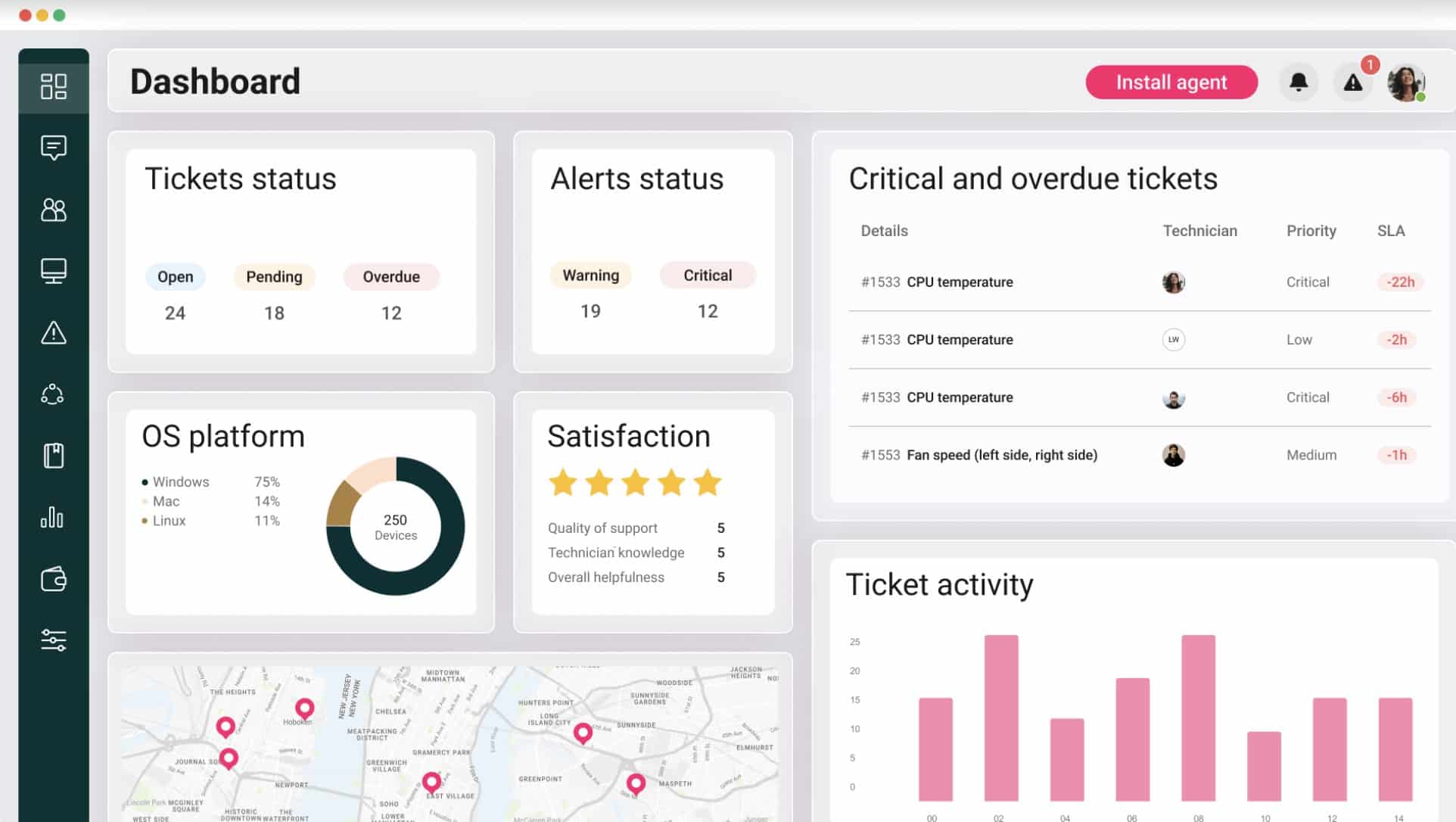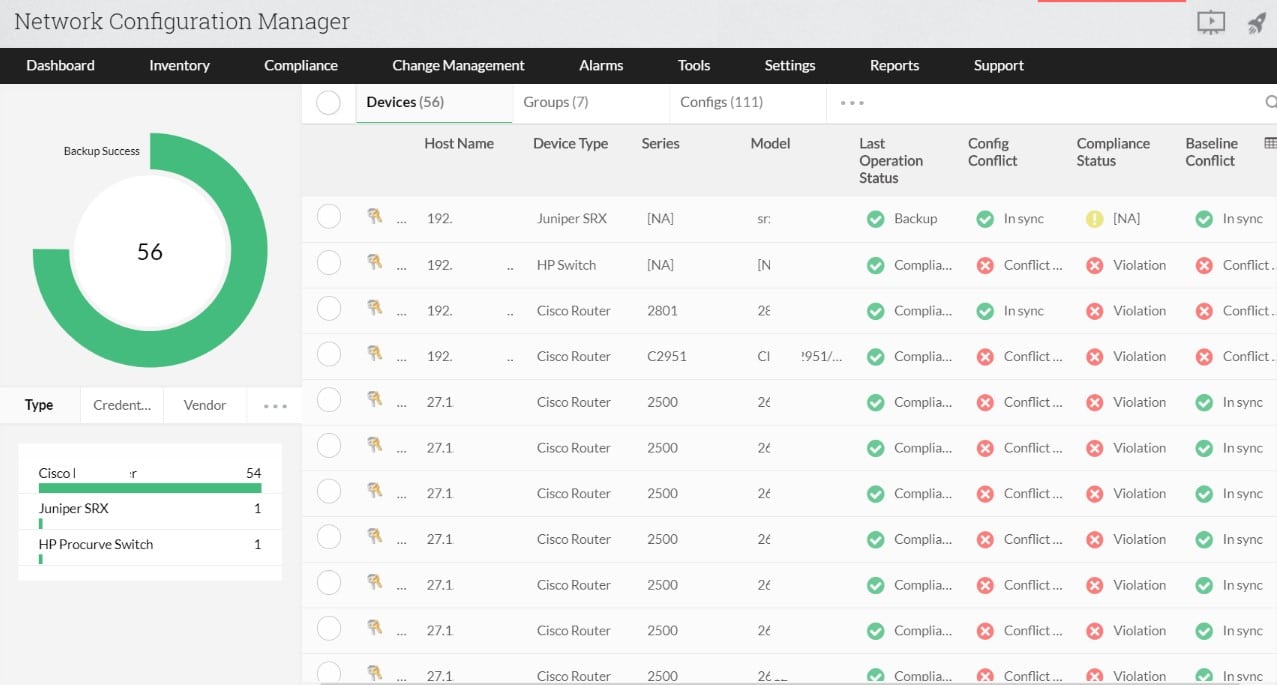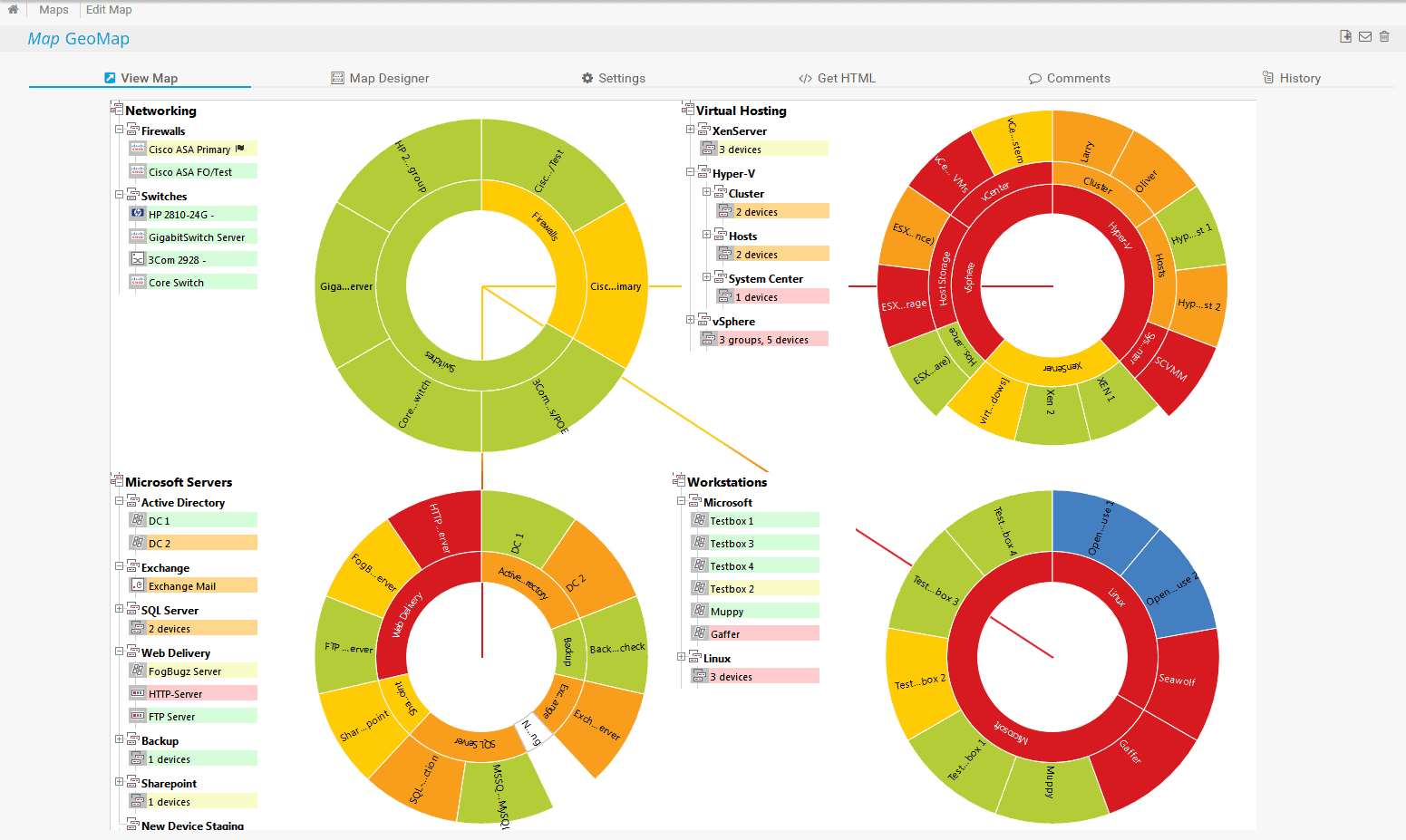We may earn a commission if you make a purchase through the links on our website.
The Best Cisco Network Magic Alternatives
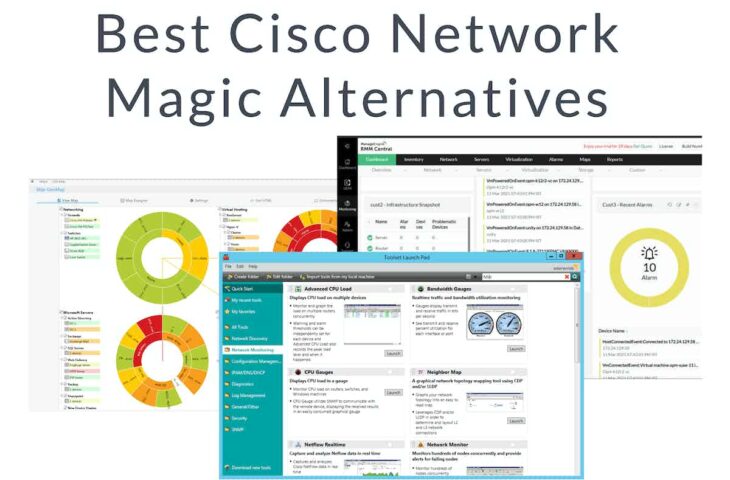
UPDATED: February 10, 2025
Since the depreciation of Network Magic by Cisco, many readers have been seeking similar solutions for remote PC management, patching, or hardware setup. This can be a difficult task since Network Magic had many unique features bundled into a single program. In this article, we’ll dive into some of the best Cisco Network Magic alternatives that are still being supported today.
Here’s our list of the best Cisco Network Magic alternatives:
- Atera – EDITOR'S CHOICE Remote monitoring, management, and IT automation make this cloud platform a great Network Magic alternative. It's ideal for MSPs, providing streamlined network management with real-time monitoring and customizable reports. Start a 30-day free trial.
- ManageEngine OpManager – FREE TRIAL Excels with comprehensive monitoring, real-time network maps, and NetFlow-based traffic analysis, making it a top choice for network administrators. Download a 30-day free trial.
- Paessler PRTG Network Monitor – FREE TRIAL Extremely flexible platform with dozens of different monitors that cover infrastructure, software, application, and security monitoring. Start a 30-day free trial.
- Spiceworks IP Scanner Free cloud service that simply scans a new network and reports back the different devices it discovered.
- SolarWinds Engineer’s Toolset Features over 60 different networking and monitoring tools that are compatible with Windows Server.
- Axence NetTools Free bundle of tools that can perform device discovery, as well as check open ports and identify services. It is ideal for smaller networks.
What features did Network Magic have?
Before Cisco stopped supporting the software, Network Magic was an incredibly flexible tool that offered a host of monitoring capabilities along with network discovery, and alerting features.
Network Magic supported:
- Auto device discovery
- Bandwidth usage monitor per PC
- Hardware and software identification for each PC
- Cross-platform communication with PC and macOS
- Basic network troubleshooting tools
- Customized alerts
- Desktop screenshot capture
- Internet access controls
Key Features:
- Remote Management: Network Magic featured a host of remote management tools which allowed you to manage files and data and even share them to remote PCs. This also allowed you access to a remote machine's file structure, which proved useful for troubleshooting and fixing simple problems like replacing a broken shortcut on a desktop.
- Troubleshooting: The troubleshooting tools included in Network Magic were intuitive and covered many different aspects of IT infrastructure. The platform could automatically fix network connectivity issues as well as give you a detailed insight into bandwidth usage, resource consumption, and network connectivity.
- Many of these tools supported an easy Wizard format which walked you through troubleshooting step by step or simply performed the tasks automatically in the background. This made a tech’s job a lot simpler, but also helped non-technical users fix problems on their own.
- Parental Controls: Content blocking could be established on a per PC basis, allowing you to restrict websites or content for your children. The program could also show you exactly how many times a certain site was accessed, giving you additional context into the user session.
- Total internet connectivity and usage were also reported, which could help parents get an idea of the total screen time their child was using. Having the option to restrict internet access and browsing activity without impacting the local area network was an impressive feature at the time.
- Topology Mapping: Another core feature with Network Magic was the ability to map out your local area network via an autodiscovery feature. This feature is now built into many different solutions and offers a map to view a live and accurate representation of your network. From a troubleshooting standpoint, this can help determine if a device is causing issues on the network, has the wrong network configuration, or doesn’t belong there in the first place.
- Alerts & Reporting: In both the free and paid versions of Network Magic came with their own alert templates and reporting features. They could export and record the IP address, MAC address, and resource utilization of each device and export it in CSV format.
In the newer programs listed below, data exports are a common feature, and many of the enterprise and business-focused tools offer in-depth integrations that allow organizations to export data to other systems for archiving, or port information directly into a ticketing system to queue in the help desk.
Nowadays many tools with similar features are geared towards enterprise use, so if you’re simply a home user looking to monitor your family network a bit better, some of these tools might be more complicated than you’re used to.
With that in mind, we’ll include some smaller home-based network monitoring tools as well.
You’ll also notice that not every tool has the exact features included in Network Magic. That is because most software tools now focus solely on either network monitoring or parental controls.
The best Cisco Network Magic alternatives
Our methodology for selecting the best Cisco Network Magic alternatives
We reviewed the market for Cisco Network Magic alternatives and analyzed tools based on the following criteria:
- Ability to constantly monitor networks in real-time
- Features that help identify each device linked to the network
- Supports recovering abandoned IP addresses
- Easy-to-read graphs and charts that help display all the statistics related to network performance
- Shows the most crucial network data on one screen and supports other screen options for more information
- Performs automated testing and alert administrators in real-time
- Free tool or a premium system with a free trial
1. Atera – FREE TRIAL
Atera is a networking monitoring and inventory management system that is designed to serve large enterprise networks, and service resellers such as MSPs. The cloud platform includes numerous tools for tech support that are geared towards simplifying the troubleshooting session and getting issues resolved quickly.
Key Features:
- Remote Monitoring: Built-in feature allows administrators to track and address inventory management issues in real-time
- SNMP Monitoring: Monitors different metrics, system resources, SQL server as well as SNMP-enabled devices
- Integration with IT Tools: Connects with other IT management systems for streamlined operations.
- Security Enhancements: Monitors DNS for potential threats and vulnerabilities to safeguard networks.
- Management Processes: Supports different management processes in the package, such as patch management, asset management, etc.
Why do we recommend it?
With Atera, you are not required to purchase the complete bundle but only pay for a monthly subscription fee for each technician. Also, it includes various features and functionalities that make it easier for administrators to detect hardware inventory changes and discover new devices within a network.
The remote monitoring and management tools included in Atera are considerably more detailed and robust than what was once in Network Magic. From network discovery to equipment and inventory management, all changes are reflected in real time and show the most up-to-date version of online devices.
In addition, Atera can also act as a patch management tool and allow technicians to RDP or remote into managed servers and workstations. Each device’s network status, hardware resources, and operating system details are easily accessible for review. For MSPs that are looking to start up their business or run without setting up their own hosted infrastructure, Atera is a great option, and considerably better than Network Magic in many areas.
Who is it recommended for?
Managed service providers and large enterprise networks might find it a highly useful tool. Also, now it offers a new version specifically designed for IT organizations and departments with similar network monitoring systems. However, for Network discovery, users might need to pay an additional fee.
Pros:
- Alerting Option: Notifies users via different channels on monitoring unusual or suspicious behavior
- Flexible: Highly customizable framework makes it extremely versatile.
- Database Support: Scalable and capable of handling several databases in a multi-tenant setting
- Automation: Automates repetitive tasks like patching and software deployment for increased efficiency.
- Patch Management: Ensures all devices are up-to-date by automatically applying security patches.
Cons:
- Multi-Tenant Features: Some of these features won't be a requirement for smaller companies.
You can test out Atera free through a 30-day free trial.
EDITOR'S CHOICE
Atera is our top pick for a Cisco Network Magic alternative because it is a cloud-based solution designed for MSPs and IT professionals. Unlike Cisco Network Magic, which primarily focuses on basic network management, Atera provides comprehensive Remote Monitoring and Management (RMM) capabilities, making it ideal for businesses that need proactive, efficient network oversight. Automation tools in the package help streamline repetitive tasks like patch management, software updates, and network device monitoring. This automation minimizes the manual effort required from IT staff, allowing them to focus on more critical tasks and improving overall operational efficiency. Atera's real-time alerts and monitoring ensure that potential issues are identified and resolved before they escalate, reducing downtime and improving system performance. This package offers a powerful ticketing system, asset management, and customizable reporting, making it easier to manage client needs and track network health. It also integrates seamlessly with other third-party tools, enhancing the versatility of the platform. Atera's multi-platform support means that it works across Windows, macOS, and Linux systems, providing flexibility for diverse environments. The mobile app ensures you can manage and monitor networks on the go, offering maximum convenience and control from anywhere.
Download: Get a 30-day FREE Trial
Official Site: https://www.atera.com/signup/
OS: Cloud-based
2. ManageEngine OpManager – FREE TRIAL
ManageEngine OpManager offers an extensive range of monitoring capabilities that cover over 100 performance metrics, including CPU/memory utilization, interface traffic, and packet drops.
Its real-time network maps provide an accurate and up-to-date visual representation of device connectivity, ensuring administrators have a clear and comprehensive view of their network topology. The tool's NetFlow-based traffic analysis offers in-depth insights into bandwidth usage, helping to manage network resources efficiently and identify potential bottlenecks.
Customizable dashboards allow users to tailor performance views to their specific needs, enhancing the overall monitoring experience. Automated alerts based on predefined thresholds enable proactive issue detection and resolution, minimizing downtime and maintaining network performance.
Pros:
- Monitoring of 100+ Metrics: Offers comprehensive monitoring of over 100 performance metrics, including CPU/memory utilization, packet drops, and interface collisions, providing in-depth network visibility.
- Real-Time Network Maps: Automatically creates and updates network maps, visually representing device connectivity and ensuring up-to-date network topology.
- NetFlow-Based Traffic Analysis: Provides in-depth traffic analysis using NetFlow, enabling detailed insights into bandwidth usage across applications, users, and devices.
- Customizable Dashboards: Allows for extensive customization of dashboards to tailor performance views to specific needs, enhancing the monitoring experience.
- Comprehensive Cisco Support: Supports a wide variety of Cisco technologies and devices, including UCS, NBAR, CBQOS, and IPSLA, ensuring thorough monitoring and management.
- Automated Alerts: Sends notifications based on predefined performance thresholds, enabling proactive issue detection and resolution.
Cons:
- Learning Curve: The extensive features and capabilities can be overwhelming for new users transitioning from simpler tools.
With extensive support for a wide variety of Cisco technologies and devices, ManageEngine OpManager is a robust, versatile, and highly effective solution for comprehensive network management. Download the 30-day free trial.
3. Paessler PRTG Network Monitor – FREE TRIAL
PRTG Network Monitor by Paessler is a staple among the IT community, and for good reason. PRTG isn’t just software, it’s an entire management platform that can be configured to monitor everything from SQL servers to PC endpoints, and everything in between. This is achieved by PRTG’s flexible monitor agents, which all install simply but are customized to monitor that specific device. The sensor collects that data and then displays valuable information back to your centralized dashboard.
Key Features:
- Auto-Discovery: Discovers new devices automatically and maps them for quick analysis
- Distributed Monitoring: Keeps an eye over networks, servers, and applications distributed across the globe
- Customizable Reporting: Generates custom and actionable insights covering network performance, trends, and other issues
- Failover Cluster: Offers automatic failover protection, i.e., if hardware fails, the workload is shifted to another server within the cluster for smooth operation
- Supports Integration: Integrates well with several network components
Why do we recommend it?
With PRTG Network Monitor, users can run auto-discovery scans, map infrastructure, and use SNMP to check on all connected equipment. Secondly, the PRTG Network Monitor software is available as a cloud service or for on-premises installation.
PRTG is more geared towards medium to enterprise-level networks with many features that are designed to be able to scale as organizations experience growth. Small home networks could use PRTG, but will likely find it to be more complex than what they need.
On the other hand, IT professionals will enjoy the platform’s auto-discovery features and easy implementation across large networks. As the agent discovers new devices, technicians can view a real-time live map that populates devices as they enter and leave the network.
Virtually all communication is captured through SNMP monitoring alongside a packet sniffer that works live on the network to pull in data on a per-packet level. Privacy is maintained by reading only the headers of the packets.
The PRTG platform performs routine checks across the network and can alert when problems are detected, conditional rules are broken, or unusual activity is found. The alerting features are robust and have features built in to help reduce alert fatigue and remove duplicate or incessant notifications. For organizations using an on-premises help desk, alerts can be routed directly to your ticketing platform through one of many PRTG integrations.
Who is it recommended for?
Both big and small enterprises can grow inside the PRTG ecosystem thanks to a pricing model that is based on sensors. There is a 500 minimum purchase amount, but no fees if you simply wish to activate 100 sensors.
Pros:
- Easy Implementation: Much simple to implement across large networks
- Supports multiple technologies: Uses a wide range of technologies and practices, including SNMP, Packet sniffing, SQL, Ping, and more to address performance issues
- Customizable Dashboard: Supports drag-and-drop options that help customize reports and other settings in the dashboard
- Alerting: Offers access to a variety of alert integrations, including email, SMS, and Slack integrations.
- Freeware Version: Offers a version or package to users at no cost
Cons:
- Time-Consuming: Users might take a bit longer to understand and explore all the functionalities and features of this comprehensive tool.
PRTG is available as both a cloud service or on-premises solution and is free to use up to 100 sensors. Experience PRTG firsthand with a 30-day free trial.
4. Spiceworks IP Scanner
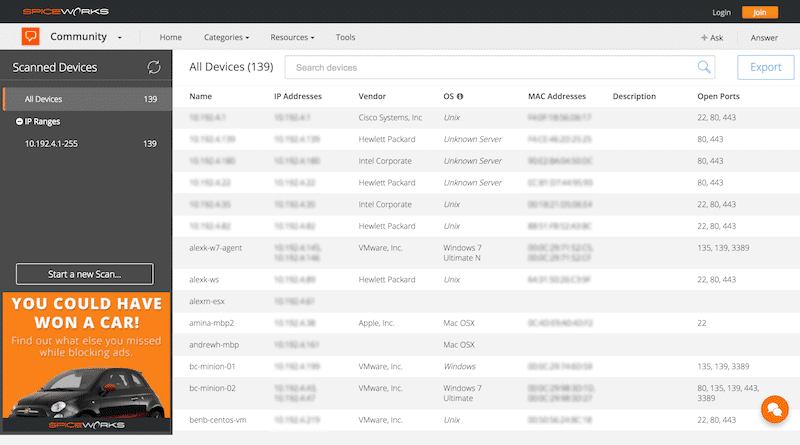
Spiceworks IP Scanner is a free, lightweight tool that installs on your network and reports network conditions back to its cloud-based service. The simple install immediately begins to scan the network and find new devices and inventory them. For Network Magic users who use the devices feature, you’ll be happy to know that Spiceworks IP Scanner works in a similar manner, and maintains that same ease of use that Network Magic once had.
Key Features:
- IP Range Customization: Helps organize and manage the IP address distribution process.
- IT Device Documentation: Runs scan on each device and generates details such as IP Address, hostname, operating system, and MAC Address
- Centralized View: Reduces troubleshooting time by combining IP, DHCP, and DNS data into a single view
- Encryption: Encrypts all communication networks for security purposes
Why do we recommend it?
Spiceworks IP Scanner is a free tool that runs scans and automatically traces all the new devices within your network and their details. Also, it encrypts all your network communications which makes it a secure solution.
Upon scanning, details such as IP address, MAC address, operating system, manufacturer, and hostname are all presented for each device that is detected. The tool also gives a brief overview of open ports on the devices, which is useful in understanding what services may be running on an endpoint.
All communications between the network discovery agent and the backend cloud are encrypted between you, and the Spiceworks server. A separate encryption key is provided that allows you to view your network information, ensuring that no one else can view that information.
These results can be exported for additional reporting or recordkeeping in CSV format. This tool is admittedly simple, however, for those who are keen on simply keeping track of devices on their network, this does an excellent job doing just that for small and medium-sized networks.
Who is it recommended for?
Small businesses can make the best use of this tool and create device inventory. Unlike other tools, Spiceworks IP Scanner does not support continuous network monitoring as it does not operate on a constant basis. Also, since it lacks automation, it might not be a perfect fit for large enterprises.
Pros:
- Free Lightweight Tool: Available for free and hardly demands excessive system resources
- Automated Testing: Performs automated testing and notify the system administrator when devices reconnect.
- Scalable: Easy-to-use UI that performs well on large networks as well
- Troubleshoot User Issues: Creates a ticket for users to resolve their issues and ensure smooth operations
- Fix Security Holes: Assigns team members to handle the OS upgrades and create tickets for open ports.
Cons:
- No Offline: Unlike other options, Spiceworks IP Scanner offers no support for offline work
- Limited Options: Does not support multiple monitoring options but only cloud-based external monitoring functionality
5. SolarWinds Engineer’s Toolset
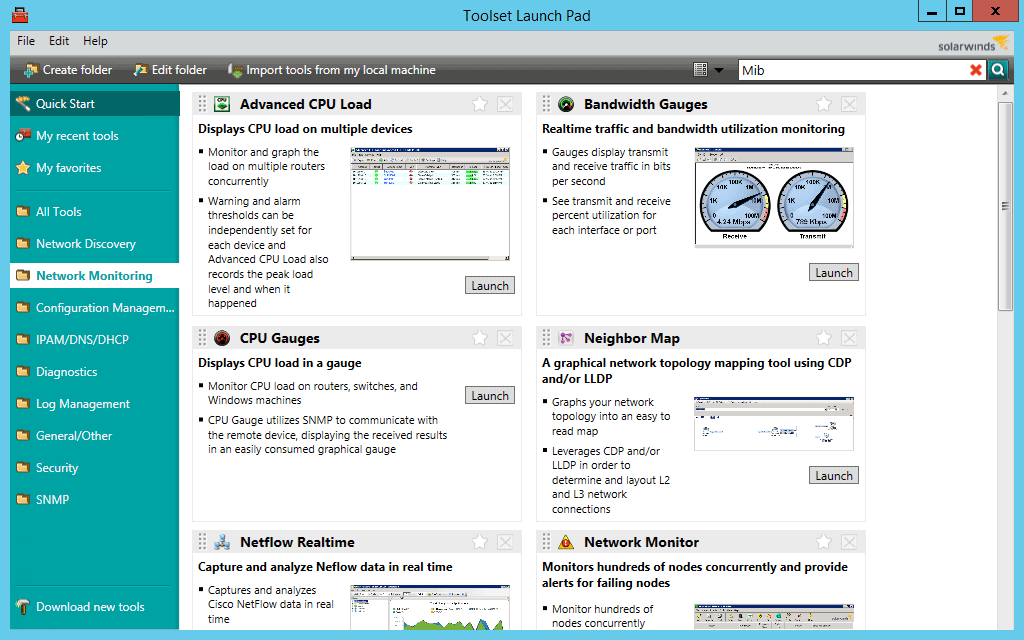
SolarWinds Engineer’s Toolset is truly a network technician’s best friend. This bundle of over 60 networking and troubleshooting tools vastly outperforms the features found in both the paid and free versions of Network Magic.
Key Features:
- Real-Time Monitoring: Allows administrators to track networks and servers in real time
- Network Stress Testing: Shows the potential effects of packet level spikes on network device performance
- Automated Network Discovery: Uses a port scanner to automatically discover devices within a network
- IP address Monitoring: Monitors and tracks how IP addresses are being used
- Supports Integration: Integrates well with SolarWinds Hybrid Cloud Observability and other tools
- Enhanced Network Security: Protects network devices against cyber threats with an additional security layer
Why do we recommend it?
SolarWinds Engineer’s Toolset supports more than 60 system management tools. Additionally, the tool comes with port scanning utilities and other features that make the whole process of monitoring network devices in real-time simple and hassle-free.
IT professionals will appreciate the thoroughness of each tool, and can simply take this wherever they are without having to wonder if they forgot to download or include a testing tool on their own USB flash drive.
These tools can perform a range of tasks including MAC address discovery, SNMP sweeps, port scanning, configuration management, network discovery, and a host of hardware testing tools. For stress testing, there are numerous tools such as WAN Killer, which sends mock traffic over the network to test its ability to handle capacity before being put into production.
On the hardware side, CPU Monitor, Memory Monitor, and Interface Monitor offer thorough testing for each component and the ability to monitor each piece of hardware overtime with full logging capabilities. Some other handy tools for techs include a subnet calculator, DHCP, DNS auditing tool, and DHCP scope monitor, which can help quickly identify under or overutilized IP ranges.
SolarWinds Engineer’s Toolset is at number one due to its vast number of helpful resources that are specifically geared towards IT professionals. With that said, even some tech-savvy home users who relied on Network Magic will be able to utilize these same tools with a little practice and research.
Who is it recommended for?
Network administrators can make the best use of this tool thanks to the several features that aid in ad-hoc investigations as well as help perform automated monitoring.
Pros:
- Easy to Use: Even users with less technical knowledge may use the tool easily thanks to the design and supported documentation
- Device Discovery and Testing: Allows administrators to stress test their network and discover new devices automatically
- IP Address and DHCP Monitoring: Assists in checking that DHCP and DNS are operational on various devices
- Scanning capabilities: Offers the ability to quickly import or export scan results
- MAC Address Scanning: Finds MAC addresses with ease and boost network efficiency
Cons:
- Short Trial Period: Trial session offered by SolarWinds Engineer’s Toolset is quite short for testing all of its features.
You can download the entire Engineer’s Toolset completely free through a 14-day free trial.
6. Axence NetTools
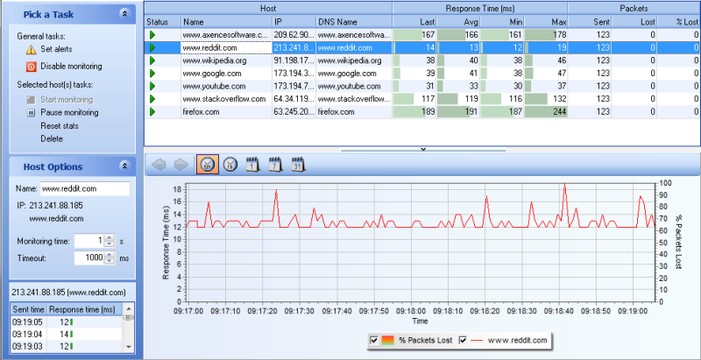
Axence NetTools is a packaged bundle of 10 different network tools that are completely free to use in a Windows environment. While the interface may seem a bit outdated, the power behind Axence free tools is on par with many similar Network Magic alternatives for smaller networks.
Key Features:
- Response Time Monitoring: Tracks the time a device takes to respond to requests
- In-Depth Insights: Offers quick insights on 50 frequently utilized ports and services
- Data Exporting: Allows admins to export all the data in different file formats, such as HTML, TXT, and XML
Why do we recommend it?
With Axence NetTools, administrators can run several ad-hoc tests, discover devices connected to the network, and trace IP address locations. Additionally, it comes with a protocol analyzer that displays the most important ports.
Just like Network Magic, Axence features a port scanner, device discovery, and service detection for new devices. Overall the tool can detect up to 50 different services, which makes it a great fit for smaller networks, but a bit restricted for larger enterprises.
Simple tools like a built-in netstat can run and detect a device's port status, as well as list the configuration information of each device. The built-in bandwidth tool can measure usage across the network as well as narrow down bandwidth hogs based on which device traffic is coming from.
The Netwatch feature is a form of continuous monitoring that consistently checks for packet loss, ICMP drops, and the DNS resolution of the targeted hostname. A traceroute function is also included, which closely mirrors the built-in Windows traceroute command. This measures the route and performance of the test packet along the way between you and the targeted machine.
Lastly, the Wintools feature scans the Windows Event Viewer logs and pulls relevant alerts to disk usage, memory errors, CPU performance, and page filing problems. This is a great timesaver, especially for help desk technicians who know just how slow and clunky a massive log repository can be in Event Viewer.
While some of these tools and tests can be performed manually through a command prompt, it’s a great alternative to save time and offers these troubleshooting techniques to a less technical audience.
Who is it recommended for?
Any network manager at a company would find this to be a useful bundle. Small enterprises would be the only ones able to utilize it as a network monitor, though. Most networks with more than a few devices attached to them cannot use the tool due to its limited capacity.
Pros:
- Free Tool: With a simple interface and graphing options
- Alerting: Updates admins about host availability issues using different channels, such as email and message
Cons:
- Supports Windows: Only fully functional on Windows
- Not Ideal for Large Businesses: Businesses with larger networks might find it a less suitable option
Related Post: Best Bandwidth Monitoring Software and Tools
Looking for Parental Controls?
One of the core features behind Network Magic was its ability to monitor PC activity simply, and restrict websites and internet traffic with relative ease. While the options listed above match or exceed the network monitoring capabilities of Network Magic, they lack the session-based monitoring you may be looking for.
Attempting to restrict certain sites manually, and decipher internet traffic manually is a futile task when it comes to controlling what your kids view online, and who they interact with. Using specialized parental control software makes this job easy, as they leverage artificial intelligence and known lists of ‘bad' sites that make blocking and restricting types of content simple.
Traditionally, network monitoring and user monitoring are separate activities that require separate software. If your focus is more centered around keeping your kids safe online, rather than monitoring the technical aspects of your network, the tools below can help.
Which Network Magic alternative is right for you?
As the years pass by, Network Magic just seemed to experience more problems, with no support or solution in sight. Switching to a tool that is supported and updated will not only help you monitor your network more efficiently but also ensure that you’re protected through security updates and patches.
If you were using Network Magic to monitor network infrastructure for a business, then switching to SolarWinds Engineer’s Toolset is your best bet. With over 60 tools tailored to virtually any technician’s needs, you’ll find that the bundle far exceeds what Network Magic alone could accomplish.
Enterprise-sized organizations will benefit greatly from the PRTG platform. Its ability to scale across thousands of endpoints and offer additional monitoring through the same dashboard simplifies the monitoring and device management process as a whole.
MSPs will find that Atera suits them the best. Its lightweight installer and cloud-based structure makes adding and managing new clients easy and offers additional inventory management and per client organizational features that were not available through Network Magic.
Lastly, families who just need to monitor their children's internet activity can use tools such as NetNanny or Qustodio to protect their kids from harmful content and restrict app usage or screen time.
Related Post: Cisco Commands Cheat Sheet
Network Magic FAQ
Can I still buy Network Magic?
No, Network Magic Pro is no longer available officially through Cisco.
Is using Cisco Network Magic illegal now?
No, using the tool is not illegal. However downloading the paid version for free from unofficial sources is illegal, and considered pirating.
Why was Cisco Network Magic discontinued?
The program was discounted when Cisco came out with their Smart Wi-Fi routers. These routers were able to automatically configure themselves and join the network. This new technology made Network Magic unnecessary.
Is Network Magic broken?
While it can still be used in some cases, many find that the tool does not work as well as it did in the past. This is because there is no longer a technical team supporting the product with updates, patches, or fixes. If you run into an issue with Network Magic, Cisco will not support fixing the problem anymore.
